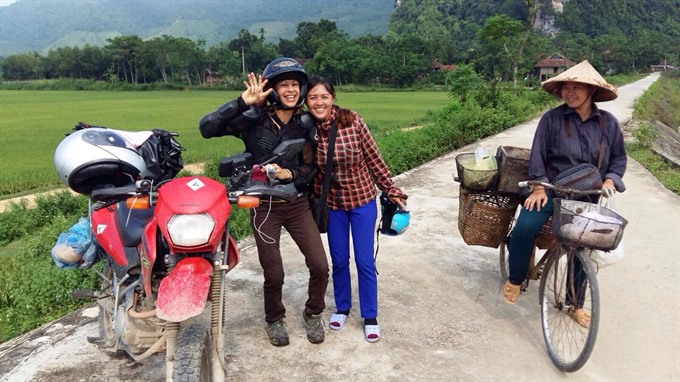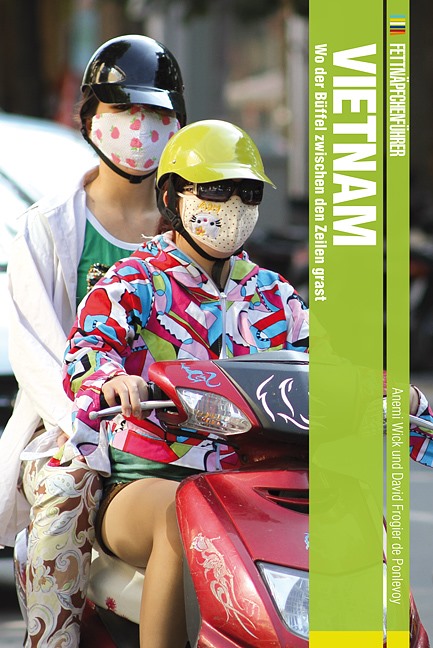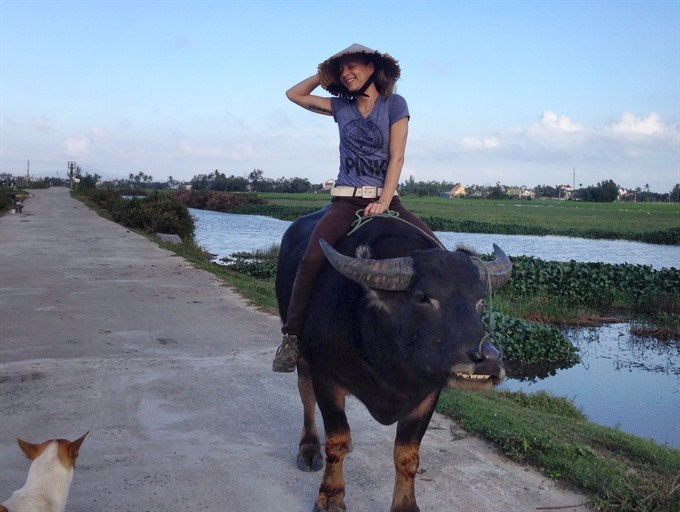Swiss writer falls in love with the back streets
Love does not always fade with time. For Swiss writer Anemi Wick, the deep love story she has had for Viet Nam for 8 years has only deepened over the years.
 |
| On the road again: Anemi Wick makes new friends as she takes to the back roads.— Photos courtesy of Anemi Wick |
The young Swiss woman came to Viet Nam for the first time for a short internship. Eight years later, she is still here, always passionate about discovering new regions and meeting new people. She has kept returning to Viet Nam for many different projects. She has worked for international and local organisations and businesses, produced videos and written articles. She was also assigned to hold workshops, talks and consultations on social media and intercultural communications.
Her latest project is a second book about Viet Nam. To be published early next year, the 700-page latest edition of the Viet Nam travel guide book is similar to Lonely Planet publications. It is being printed in German by German publisher Reise Know-How.
It took Wick more than a year to write the book after numerous trips throughout the country, meeting local people and foreigners who have been living in Viet Nam for many years.
 |
| First book: The cover page of Anemic Wick’s first book about Viet Nam published 4 years ago. The book’s title in English is: 'Where The Buffalo Grazes Between The Lines'. |
“They gave me great advice, and showed me their favourite things, from the special chili sauce in Hai Phong to the coolest night club in HCM City to an alley in southern Can Tho where the locals eat stinky tofu hot pot. This book would not be half as good without all the insight from my friends,” she said.
“When I was in Hoi An, I asked a local Facebook group where to find the best Banh Mi (Vietnamese bread rolls). Lots of people sent me addresses and I went to try all their suggestions, including a small stall on a street corner run by an old lady. I focused a lot on street food specialties, with pictures and a glossary, so people can explore and also order food at places with no menus in English.”
“And after all, I didn’t have to write the book from scratch. The previous editions by previous authors were the basis for my research,” she said.
“Probably the biggest challenge when writing and updating a guide book is how fast Viet Nam is changing. Also, with the internet, the way people use guide books has changed. Endless listings of hotels and restaurants have become less useful, readers expect more background information, inside knowledge, opinions and recommendations for helpful up-to-date apps and websites instead, from a reputable, trustworthy and independent source.”
 |
| Getting there: Riding a buffalo in Hoi An was among Wick’s great experiences. Photos courtesy of Anemi Wick |
Four years ago, Wick wrote her first book, Fettnäpfchenführer Viet Nam – Wo der Büffel zwischen den Zeilen grast (translates into ‘Where The Buffalo Grazes Between The Lines’), which is not a travel guidebook, but more of a cultural guidebook, told in anecdotes. It basically consists of funny, confusing or embarrassing situations foreigners may find themselves in while travelling or working in Viet Nam.
“These are true stories which either I, my co-author or our expat friends have experienced. We had our Vietnamese friends explain these mysteries and misunderstandings (for example how to queue in Viet Nam, how to order food, how to negotiate, why people tell you that you’re fat, when to yell ’em ơi!’, when to sigh ‘oi gioi oi!’, and how to read between the lines, decipher smiles and master conversations more confusing than Ha Noi’s electrical wiring,” she said.
“So the intention of the book was to make the readers understand Viet Nam better, in an entertaining way.”
The book was received well. We got good reviews and feedback.
Asked why Viet Nam attracted her so much, the answer was simple. “Because every place and region of Viet Nam is exciting and wonderful to explore.”
“The magical beauty of the landscape near Dong Van in Ha Giang Province blew my mind, and the remoteness of a small village in the highlands in Kon Tum Province where the people don’t have motorbikes nor electricity and they showed me where they set up squirrel traps, how they cook cassava and taught me a few words in Bahnar language.
"Visiting the islands in Bai Tu Long Bay was a great adventure. I was there in November, I was the only tourist on Ngọc Vừng Island, and got completely lost on Tra Ban Island. To drive the Ho Chi Minh Highway on a motorbike with my friend around Phong Nha-Ke Bang was one of my best trips.
"My favourite street food meal is in Kon Tum at a local stall at an intersection that served Pho khô (a rice noodle dish with beef and broth), for 25,000 VND (1.1 USD). It was fantastic!”
Anemic Wick remembers one time in Vinh, where few foreigners visit, she met a group of young, friendly and enthusiastic local tour guides who hope to make the beautiful Nghe An Province more accessible to foreign travelers. They show them Ho Chi Minh’s birth place, organise tours to Pu Mat National Park and share their own personal fresh and modern views on their country and its future.
“Generally, I think travellers really appreciate the chance to make friends and meaningful connections with locals, talk to them about families, hopes and dreams and everyday life, have a laugh together and share a meal. That’s how you get to know and love a country, much more than with, let’s say staged, touristy so-called traditional dance performances or sites cluttered with souvenir shops,” she says.
Viet Nam has become a second home for her. As an experienced traveller in Viet Nam, she wants to tell travellers not to rush to see the whole country in two weeks.
“Take your time, you will have the most memorable adventures not on a tourist boat in Ha Long Bay, but when you venture into small alleys and back roads, get lost in the middle of nowhere, sit down on a plastic chair in places where only locals go, eat a bowl of ‘pho’ (noodle soup) and drink a strong ‘ca phe sua da’ (iced milk coffee). Try to communicate with people, even if they don’t speak English, and just see what happens.
“Travelling with a motorbike guide is a great way to discover the country, and some of these guides are very professional and fun, full of stories and knowledge, and offer day trips to places less travelled,” she said.
(Source: VNS)